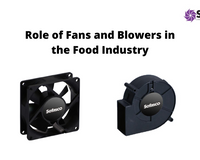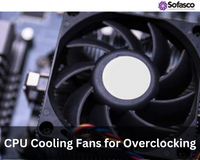Electronic cooling fans, as the name implies, are used in various electronic systems and equipment to cool them as these devices generate heat during continuous use. So, these fans find a large application across industrial segments such as telecommunication, industrial manufacturing units, lab equipment, exhaust systems, HVAC systems, defense, computers, and so on. Primarily these fans use a motor to draw power and blow air at the required speed and direction. They are absolutely essential as excessively heated equipment may lead to wear and tear, further damage, or functional failure. But, when choosing a fan for your device, you need to consider the air flow static pressure characteristics, dimensions, impellers, and so on. This post discusses the structure and characteristics of electronic cooling fans.

Electronic Cooling Fans Structure Based on Types
Electronic cooling fans are available in various sizes and types such as axial, centrifugal, and so on. The structure and air flow static pressure characteristics differ with the type and size. In most types there are AC as well as DC fans. Here are various types of electronic cooling fans and a brief about their structure:
Axial Fans:
These fans have been used since decades across industries. As the name suggests, their blades rotate around an axis and draw as well as blow out air in the parallel direction. allow gases or air to flow in the direction parallel to the blade or the shaft on which the blades rotate. Axial fans can be of AC or DC type, and have low, medium, or high speeds. An axial fan is of two categories- tube axial and vane axial cooling fans.
- A tube axial fan is an improved version of the propeller fan as it overcomes the latter’s drawbacks.
- A vane axial fan has vanes which help straighten the air flow by lagging behind the propeller, as the air picks up speed.
Centrifugal Fans:
These fans are also called centrifugal blowers. Centrifugal fans have a number of blades placed in a circular manner. They also have rotating impellers which push out air in the required direction. It is enclosed in a casing which helps maintain the direction of outgoing air. The air flow is managed through ducts or tubes, which helps maintain a steady air flow. This structure helps increase the flow of incoming air. Centrifugal blowers have forward and backward curved wheels, which help in the rapid movement of air.
Cross Flow Fans:
Also known as tangential or blower wheel fans, these fans facilitate a wide, uniform air flow parallel to the unit to be cooled. They are highly efficient and offer low noise ratios. These fans have a cylindrical shaped impeller which varies in length depending on the model and brand. These are usually quite compact, and can be installed in small spaces, corners, and so on.
Most cooling fans are resistant to water and dust and hence find application in harsh industrial environments. Apart from the dust and water proof blowers, these fans have serial units for increased air flow in high static pressure units.
Air Flow and Static Pressure Characteristics of Electronic Cooling Fans
The static pressure of a cooling fan is an important aspect to consider when choosing a fan for an industrial application or electronic device. So, what is air flow and static pressure, and what is the relation between these two aspects?
Air flow:
Primarily, air flow is the total amount of air generated by the fan in a given amount of time. It is measured in cubic meters per minute. So, depending upon the area of enclosure and the total amount of air flow both inward and outward, you can estimate the time it will take to ventilate and cool the device. You need to calculate this time required based on your application needs.
Static Pressure:
This is the amount of pressure generated by the fan in its casing or enclosure, and is measured in Pascals. A manufacturer always mentions the maximum value for air flow and static pressure.
Relation Between Air Flow and Static Pressure:
These two are inversely proportional to each other. So, when the air flow increases, the static pressure decreases, and vice versa. This, however, also depends upon the structure of the enclosure. This is because if the enclosure has openings or is open at one end, the air flow would increase and the static pressure would come down to zero. On the other hand, if the enclosure does not have enough openings, it will block the air flow and reduce the flow rate. This would build static pressure inside the enclosure. In this case, if the static pressure reaches its maximum value, it would block the incoming air even if the fan continues its motion. This defeats the whole purpose of cooling a device.
Impedance:
So, impedance, which means blocking of air or resistance to air flow is an important factor. This helps determine the actual static pressure and air flow required for the fan to function appropriately. We need to consider all the factors which cause impedance. These include positioning of components, number of holes and openings in an enclosure, and so on. This will facilitate a close to perfect enclosure design with the required amount of ventilation.
Other Factors Affecting Air Flow:
In an enclosure, if there are too many components, the air flow may decrease. So the density of components plays a role in increasing or decreasing the airflow. Additionally, it is important to consider the environmental conditions in the area and the outside temperature, as all these external parameters may affect the system temperature, depending on its insulation features.
If you are an OEM and have newly installed or equipment which require industrial cooling fans, ensure you consider all the above discussed factors of air flow and static pressure statistics before making a buying decision. Next, focus on their quality. This you can easily assure by sourcing from a reliable manufacturer and supplier. Sofasco designs, develops, and manufactures integrated cooling solutions, which can be customized to suit your exact requirement.












